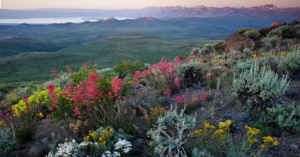Returning to Wild
How the story of the Bodie Hills is being rewritten through conservation
Today the Bodie Hills have been classified as some of the highest ecological intactness and species richness in the region.
 Looking out across the rolling hills blanketed with sagebrush and juniper, painted with vibrant splashes of wildflowers, with the high peaks of the Sierra rising in the distance, the Bodie Hills feel every bit as wild as they are. Just an hour or so outside Yosemite National Park, the roughly 123,000-acre Bodie Hills stretch between the Sierra Nevada mountains to the west and Great Basin to the east.
Looking out across the rolling hills blanketed with sagebrush and juniper, painted with vibrant splashes of wildflowers, with the high peaks of the Sierra rising in the distance, the Bodie Hills feel every bit as wild as they are. Just an hour or so outside Yosemite National Park, the roughly 123,000-acre Bodie Hills stretch between the Sierra Nevada mountains to the west and Great Basin to the east.

The ghost town of Bodie is a reminder of the countless people who tried to make a hard living off the land.
Scattered throughout the hills are reminders of the countless people who tried to make a hard living off the land. The ghost town of Bodie, now a State Park, gives a snapshot of their lives, frozen in time as the gold and silver mines went bust: dishes left in the cupboard, a baby carriage abandoned in the corner, prospecting tools leaned against a wall. Across the hills the corrals of ranchers have fallen to a scattering of sun-bleached poles. If you know what you’re looking for, prospecting pits and tailings can be found overgrown and reclaimed by the land, covering their stories of hope and disappointment. Thousands came to make their fortune in the 1860s, each with their own story and connection to the land, but in less than 60 years they were gone again, leaving the juniper, the sage grouse, pika, pronghorn antelope and golden eagles to reclaim their old territories. Even the wild horses and burros who roam the Bodie Hills tell the story of what was once domesticated becoming wild once again.
Well before and well after the boom and bust of mining, the Mono Lake Kootzaduka’a and Bridgeport Tribes have been a constant presence as stewards in the Bodie Hills and throughout their homelands. Today the Bodie Hills have been classified as some of the highest ecological intactness and species richness in the region, rating in the top 10% of unprotected Bureau of Land Management lands in California for biodiversity. As a transitional ecosystem between the Sierra Nevada and Great Basin they are home to rare species like the Bi-State Sage Grouse and Lahontan Cutthroat trout. The story of how people are connected to the landscape of the Bodie Hills is changing, away from one about what can be taken from the land toward one about what can be preserved on the land. Their value has shifted from what lies in veins under the ground to their recreational opportunities and vibrant ecosystems which hold 1.95 mega tons of sequestered carbon.

The Bodie Hills are home to rare species like the Bi-State Sage Grouse.
Three Wilderness Study Areas cover much of the Bodie Hills, but large parcels of private land and 200 active mining claims are also scattered throughout. For years The Wilderness Land Trust has been working to acquire these parcels and transfer them to public ownership, having successfully protected over 6,400 acres. Our work there continues as we pursue transfer of three large parcels and conduct sage grouse habitat restoration on them in partnership with local organizations and tribes. Protecting these lands under public ownership will help ensure their story continues to evolve to one of balance, where the riches of their biodiversity and beauty are shared by all.


